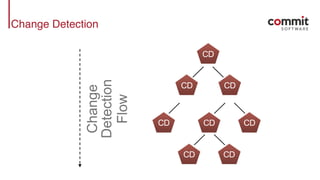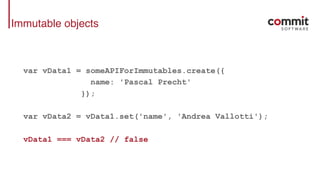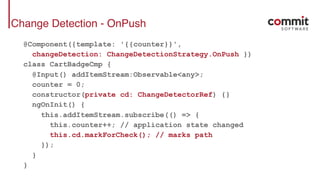Angular 2 - The Next Framework
- 1. Angular 2 - The Next Framework
- 2. Angular 2 – The Next Framework
- 3. AngularJS history • AngularJS was originally developed in 2009 by Misko Heveryand Adam Abrons • Misko Heverystarted to work for Google in 2009 • 1st release of AngularJS: 1 developer, 3 weeks, 1000 loc • AngularJS version 1.0 was released in 2012 by Google • Angular version 2 was released in September 2016 after 2 years development
- 4. Angular 2 features • Optimized for both desktop and mobile • Ahead of Time (AoT) compilation • Incredible performances • Native Reactive support
- 5. @Injectable
- 6. @Injectable export class MyService { getData() { return this.loadData.load(); } }
- 7. @Injectable import { Injectable } from 'angular2/core'; @Injectable() export class MyService { constructor(private loadData:LoadData) {} getData() { return this.loadData.load(); } }
- 8. @Component
- 9. @Component import { Component } from '@angular/core'; @Component({ selector: 'commit-hello', template: '<p>Hello, {{name}}</p>' }) export class Hello { name: string; constructor() { this.name = 'World'; } }
- 10. @Directive
- 11. @Directive import { Directive, HostListener } from '@angular/core'; @Directive({ selector: '[confirm]' }) export class ConfirmDirective { @HostListener('click', ['$event']) confirmFirst(event: Event) { return window.confirm( 'Are you sure you want to do this?'); } }
- 12. @Directive // Usage <button type="button" (click)="visitOtherPage()" confirm>Visit another page</button>
- 13. @Directive – ngFor example <ul> <li *ngFor="let doctor of doctors; let idx = index"> Doctor #{{idx}} - {{doctor.name}} </li> </ul>
- 14. @Pipe
- 15. @Pipe import { Component } from '@angular/core'; @Component({ selector: 'product-price', template: '<p>Price: {{ price | currency }}</p>' }) export class ProductPrice { price: number = 99.99; }
- 16. @Pipe import { Pipe, PipeTransform } from '@angular/core'; const UNITS = ['B', 'KB', 'MB', 'GB']; @Pipe({ name: 'formatFileSize' }) export class FormatSize implements PipeTransform { transform(bytes: number=0, precision: number=2) : string { if (!isFinite(bytes)) return '?'; let unit = 0; while ( bytes >= 1024 ) { bytes /= 1024; unit ++; } return bytes.toFixed(precision) + ' ' + UNITS[unit]; } }
- 17. HTTP services
- 18. HTTP services import {Injectable} from '@angular/core'; import {Http, Response} from '@angular/http'; import {Observable} from 'rxjs'; import {Hero} from './hero'; @Injectable() export class LoadDataService { constructor(private http: Http) {} search(term: string): Observable<Hero[]> { return this.http .get(`app/heroes/?name=${term}`) .map((r: Response) => r.json().data as Hero[] ); } }
- 19. TypeScript
- 20. Why TypeScript? • Angular2 Dependency Injection system is based on type reflection • Annotations offer a powerful and very expressive way to describe elements
- 21. Pros • Improve developer experience with better tools • Compile time error check • Type safety • Better documentation • Easy to adopt for backend developers
- 22. Cons • Slower learning curve for traditional javascript developer • Impossible to remove without a complete rewrite
- 24. Modern web is all about components • Thinking of components instead of views improves decoupling and separation of concerns • Components are composable and highly reusable • Easier to test • UX and UI teams integrate better
- 25. A component is… • exported as a custom HTML tag: <tab-bar /> • defined by an HTML template • enhanced using the @Component decorator • controlled using its inputs and outputs • initialized by Angular Dependency Injection engine
- 26. @Component – selector import { Component } from '@angular/core'; @Component({ selector: 'commit-hello', template: '<p>Hello, {{name}}</p>' }) export class Hello { name: string; constructor() { this.name = 'World'; } }
- 27. @Component – selector selector is the element property that we use to tell Angular to create and insert an instance of this component.
- 28. @Component – template • template is an HTML string that tells Angular what needs to be to rendered in the DOM. • templateUrl is a relative path to a file containing the component HTML string.
- 29. Template syntax • template tags {{expression}} – Execute arbitrary expressions, e.g. {{1+1}} • property binding [attribute]="propertyName" – Used to pass data to a component. • event binding (event)="expression" – Expression executed anytime the registered event fires. • 2-way binding <input [(ngModel)]="u.name"> – Requires to import 'FormsModule' to be used.
- 30. @Component – inputs import { Component, Input } from '@angular/core'; @Component({ selector: 'commit-hello', template: '<p>Hello, {{name}}</p>' }) export class Hello { @Input() name: string; }
- 31. @Component – inputs import { Component } from '@angular/core'; @Component({ selector: 'commit-hello', inputs: ['name'] template: '<p>Hello, {{name}}</p>' }) export class Hello { }
- 32. @Component – inputs // To bind to a raw string <commit-hello name="World"></commit-hello> // To bind to a variable in the parent component <commit-hello [name]="userName"></commit-hello>
- 33. @Component – outputs import { Component, EventEmitter, Output } from '@angular/core'; @Component({ selector: 'counter', template: `<div><p>Count: {{count}}</p> <button (click)="increment()">Increment</button></div>`}) export class Counter { count: number = 0; @Output() result: EventEmitter = new EventEmitter(); increment() { this.count++; this.result.emit(this.count); } }
- 34. @Component – child components import { Component, ViewChild } from '@angular/core'; import { Alert } from './alert.component'; @Component({ selector: `app`, template: `<alert>My alert</alert> <button (click)="showAlert()">Show Alert</button>` }) export class App { @ViewChild(Alert) alert: Alert; showAlert() { this.alert.show(); } }
- 35. @Component – child components import { Component, ViewChild } from '@angular/core'; import { Alert } from './alert.component'; @Component({ selector: `app`, template: `<alert>My alert</alert> <input #msg type="text" /> <button (click)="showAlert()">Show Alert</button>`}) export class App { @ViewChild(Alert) alert: Alert; @ViewChild('msg') msgInput; showAlert() { const txt = this.msgInput.nativeElement.value; this.alert.show(txt); } }
- 36. @Component – transclusion import { Component, Input } from '@angular/core'; @Component({ selector: `commit-hello`, template: `<div><p>Hello, {{name}}</p> <ng-content><p>No extra data</p></ng-content> </div>`}) export class Hello { @Input() name: string; } //Usage <commit-hello name="Andrea"> <div> <h1>Some other data</h1> <p>Some text</p> </div> </commit-hello>
- 38. Components & Directives shared lifecycle Method Decription ngOnChanges input property value changes ngOnInit initialization step ngDoCheck every change detection cycle ngOnDestroy before destruction
- 39. @Component – lifecycle import { Component, OnInit } from '@angular/core'; @Component({ selector: 'commit-hello', template: '<p>Hello, {{name}}</p>' }) export class Hello implements OnInit { name: string; constructor() { this.name = 'World'; } ngOnInit() { // do something to initialize the component } }
- 40. @Directive – lifecycle import { Directive, OnInit, OnDestroy } from '@angular/core'; @Directive({selector: '[mySpy]'}) export class SpyDirective implements OnInit, OnDestroy { constructor(private logger: LoggerService) { } ngOnInit() { this.logIt(`onInit`); } ngOnDestroy() { this.logIt(`onDestroy`); } private logIt(msg: string) { this.logger.log(`Spy ${msg}`); } } //Usage <div mySpy>...</div>
- 41. Lifecycle “Angular only calls a directive/component hook method if it is defined.” – Angular official docs
- 42. Component styles
- 43. Inline styles import { Component } from '@angular/core'; const baseStyle = { backgroundColor: 'green', padding: '10px' }; @Component({ selector: 'commit-hello', template: '<p [ngStyle]="style">Hello!</p>' }) export class Hello { style: any = baseStyle; }
- 44. View encapsulation • Emulated (default) – styles from main HTML propagate to the component. Styles defined in this component's @Component decorator are scoped to this component only. • Native (shadow DOM) – styles from main HTML do not propagate to the component. Styles defined in this component's @Component decorator are scoped to this component only. • None – styles from the component propagate back to the main HTML and therefore are visible to all components on the page.
- 45. View encapsulation – example (1/2) import { Component, ViewEncapsulation } from '@angular/core'; @Component({ selector: 'commit-hello', styles:[` .main { background-color: green; padding: 10px; } `], encapsulation: ViewEncapsulation.Emulated, template: '<p class="main">Hello!</p>' }) export class Hello { }
- 46. View encapsulation – example (2/2) //Output HTML <p class="main" _ngcontent-yok-5=""> Hello! </p> //Output CSS (inside <head>) .main[_ngcontent-yok-5] { background-color: green; padding: 10px; }
- 47. Be Reactive!
- 48. Observables “Observables open up a continuous channel of communication in which multiple values of data can be emitted over time […] Angular 2 uses observables extensively - you'll see them in the HTTP service and the event system…” – Angular official docs
- 49. Stream “A stream is a sequence of ongoing events ordered in time. It can emit 3 different things: a value, an error, or a «completed» signal. Consider that the «completed» takes place, for instance, when the current window is closed.” – A. Staltz
- 50. Observables vs. Promises • Both provide us with abstractions that help us deal with the asynchronous nature of our applications. • Observables are cancellable. • Observables can be retried using one of the retry operators provided by the API, such as retry and retryWhen. • Promises require the caller to have access to the original function that returned the promise in order to have a retry capability.
- 51. Observable (1/2) import { Observable } from 'rxjs/Observable'; const dataStream = new Observable((observer) => { setTimeout(() => { observer.next(42); }, 1000); setTimeout(() => { observer.next(43); }, 2000); setTimeout(() => { observer.complete(); }, 3000); }); const subscription = dataStream.subscribe( (value) => console.log(`Value ${value}`), (error) => console.log(`Error!!!`), () => console.log(`Completed`) );
- 52. Observable (2/2) import { Component, OnInit, ViewChild } from `@angular/core`; import { Observable } from 'rxjs'; @Component({ selector: `app`, template: `<input type="text" #username />` }) export class App implements OnInit { @ViewChild(`username`) username: any; ngOnInit(): void { Observable .fromEvent(this.username.nativeElement, 'keyup') .map((e: any) => e.target.value) .filter((text: string) => text.length > 5) .debounceTime(1000) .subscribe((text: string) => this.submit(text)); } submit(text: string): void { console.log('submitted: ', text); } }
- 54. Bootstrapping Angular • Bootstrapping is an essential process in Angular – it is where the application is loaded when Angular comes to life. • Bootstrapping Angular 2 applications is certainly different from Angular 1.x, but is still a straightforward procedure.
- 55. Define a module // app.modules.ts import { BrowserModule } from '@angular/platformbrowser'; import { NgModule } from '@angular/core'; import { HttpModule } from '@angular/http'; import { AppComponent } from './[PATH]/app.component'; import { MyComponent } from './[PATH]/some.component'; import { SomeService } from './[PATH]/some.service'; @NgModule({ declarations: [AppComponent, MyComponent], providers: [SomeService], imports: [BrowserModule, HttpModule], bootstrap: [AppComponent] }) class AppModule {}
- 56. Bootstrapping Angular // main.ts import { platformBrowserDynamic } from '@angular/platform-browser-dynamic'; import { AppModule } from './app/'; // Bootstrap main component platformBrowserDynamic().bootstrapModule(AppModule);
- 57. angular-cli • Angular command line interface • Works with Node.js and npm • Fast project setup: • npm install -g angular-cli • ng new <project name> • cd <project name> • ng serve
- 58. Under the hood
- 59. AngularJS $digest cycle • AngularJS engine is built using a dirty checking algorithm. • Application state is a single entity connected to every visual component and calculated every time a component mutates some data • It’s very easy to trigger unwanted $digest cycles impacting performances • Very difficult to debug
- 60. Angular 2 Change Detection engine • Based on ngZone • Recalculate the components tree state after every async interaction (events, timers, observables..) • Every component has its own Change Detector • Component’s Change Detector is generated at runtime to improve performances • Developers can control how and when components are recalculated
- 61. Change Detection “When one of the components change, no matter where in the tree it is, a change detection pass is triggered for the whole tree, from top to bottom.” – ngBook2
- 62. Change Detection @Component({ template: '<v-card [vData]="vData"></v-card>' }) class VCardApp { constructor() { this.vData = { name: 'Andrea Vallotti', email: '[email protected]' } } changeData() { this.vData.name = 'Pascal Precht'; } }
- 63. Change Detection CD CD CD CD CDCD CD CD Change Detection Flow
- 64. Change Detection • Every component gets a change detector responsible for checking the bindings defined in its template • Change detection strategies: • default: update the component every time data changes • on push: update the component only when its inputs change or the component requests to be updated
- 65. Immutable objects var vData1 = someAPIForImmutables.create({ name: 'Pascal Precht' }); var vData2 = vData1.set('name', 'Andrea Vallotti'); vData1 === vData2 // false
- 66. Change Detection - OnPush @Component({ template: '<h2>{{vData.name}}</h2> <span>{{vData.email}}</span>', changeDetection: ChangeDetectionStrategy.OnPush }) class VCardCmp { @Input() vData; }
- 67. Change Detection – OnPush + Immutables CD CD CD CD CD CD Change Detection Flow
- 68. Change Detection - OnPush @Component({template: '{{counter}}', changeDetection: ChangeDetectionStrategy.OnPush }) class CartBadgeCmp { @Input() addItemStream:Observable<any>; counter = 0; constructor(private cd: ChangeDetectorRef) {} ngOnInit() { this.addItemStream.subscribe(() => { this.counter++; // application state changed this.cd.markForCheck(); // marks path }); } }
- 69. Change Detection – OnPush + Observables CD CD CD CD Change Detection Flow
- 70. Links & credits • Matteo Ronchi – @cef62, https://github.com/cef62 • https://github.com/commit-university/exploring-angular-2 • http://pascalprecht.github.io/slides/angular-2-change-detection- explained/#/ • https://angular.io/docs/ts/latest/
- 71. thank you for your attention Andrea Vallotti, ph.D [email protected]











![@Directive
import { Directive, HostListener } from '@angular/core';
@Directive({
selector: '[confirm]'
})
export class ConfirmDirective {
@HostListener('click', ['$event'])
confirmFirst(event: Event) {
return window.confirm(
'Are you sure you want to do this?');
}
}](https://image.slidesharecdn.com/angular2-thenextframework-v1-161213115228/85/Angular-2-The-Next-Framework-11-320.jpg)




![@Pipe
import { Pipe, PipeTransform } from '@angular/core';
const UNITS = ['B', 'KB', 'MB', 'GB'];
@Pipe({ name: 'formatFileSize' })
export class FormatSize implements PipeTransform {
transform(bytes: number=0, precision: number=2) : string {
if (!isFinite(bytes)) return '?';
let unit = 0;
while ( bytes >= 1024 ) {
bytes /= 1024;
unit ++;
}
return bytes.toFixed(precision) + ' ' + UNITS[unit];
}
}](https://image.slidesharecdn.com/angular2-thenextframework-v1-161213115228/85/Angular-2-The-Next-Framework-16-320.jpg)

![HTTP services
import {Injectable} from '@angular/core';
import {Http, Response} from '@angular/http';
import {Observable} from 'rxjs';
import {Hero} from './hero';
@Injectable()
export class LoadDataService {
constructor(private http: Http) {}
search(term: string): Observable<Hero[]> {
return this.http
.get(`app/heroes/?name=${term}`)
.map((r: Response) => r.json().data as Hero[] );
}
}](https://image.slidesharecdn.com/angular2-thenextframework-v1-161213115228/85/Angular-2-The-Next-Framework-18-320.jpg)

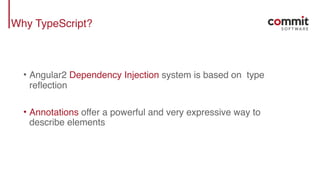







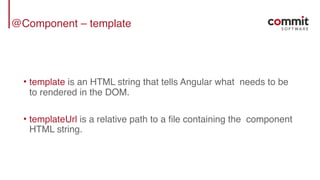
![Template syntax
• template tags {{expression}} – Execute arbitrary
expressions, e.g. {{1+1}}
• property binding [attribute]="propertyName" – Used to
pass data to a component.
• event binding (event)="expression" – Expression executed
anytime the registered event fires.
• 2-way binding <input [(ngModel)]="u.name"> – Requires
to import 'FormsModule' to be used.](https://image.slidesharecdn.com/angular2-thenextframework-v1-161213115228/85/Angular-2-The-Next-Framework-29-320.jpg)

![@Component – inputs
import { Component } from '@angular/core';
@Component({
selector: 'commit-hello',
inputs: ['name']
template: '<p>Hello, {{name}}</p>'
})
export class Hello {
}](https://image.slidesharecdn.com/angular2-thenextframework-v1-161213115228/85/Angular-2-The-Next-Framework-31-320.jpg)
![@Component – inputs
// To bind to a raw string
<commit-hello name="World"></commit-hello>
// To bind to a variable in the parent component
<commit-hello [name]="userName"></commit-hello>](https://image.slidesharecdn.com/angular2-thenextframework-v1-161213115228/85/Angular-2-The-Next-Framework-32-320.jpg)

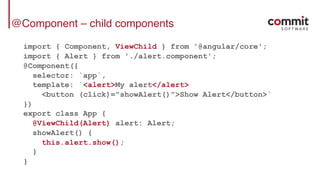

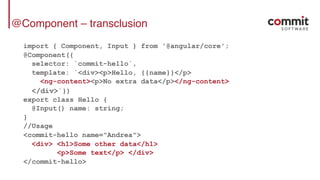



![@Directive – lifecycle
import { Directive, OnInit, OnDestroy } from '@angular/core';
@Directive({selector: '[mySpy]'})
export class SpyDirective implements OnInit, OnDestroy {
constructor(private logger: LoggerService) { }
ngOnInit() { this.logIt(`onInit`); }
ngOnDestroy() { this.logIt(`onDestroy`); }
private logIt(msg: string) {
this.logger.log(`Spy ${msg}`);
}
}
//Usage
<div mySpy>...</div>](https://image.slidesharecdn.com/angular2-thenextframework-v1-161213115228/85/Angular-2-The-Next-Framework-40-320.jpg)


![Inline styles
import { Component } from '@angular/core';
const baseStyle = {
backgroundColor: 'green',
padding: '10px'
};
@Component({
selector: 'commit-hello',
template: '<p [ngStyle]="style">Hello!</p>'
})
export class Hello {
style: any = baseStyle;
}](https://image.slidesharecdn.com/angular2-thenextframework-v1-161213115228/85/Angular-2-The-Next-Framework-43-320.jpg)

![View encapsulation – example (1/2)
import { Component, ViewEncapsulation } from '@angular/core';
@Component({
selector: 'commit-hello',
styles:[`
.main {
background-color: green;
padding: 10px;
}
`],
encapsulation: ViewEncapsulation.Emulated,
template: '<p class="main">Hello!</p>'
})
export class Hello { }](https://image.slidesharecdn.com/angular2-thenextframework-v1-161213115228/85/Angular-2-The-Next-Framework-45-320.jpg)
![View encapsulation – example (2/2)
//Output HTML
<p class="main" _ngcontent-yok-5="">
Hello!
</p>
//Output CSS (inside <head>)
.main[_ngcontent-yok-5] {
background-color: green;
padding: 10px;
}](https://image.slidesharecdn.com/angular2-thenextframework-v1-161213115228/85/Angular-2-The-Next-Framework-46-320.jpg)

![Observables
“Observables open up a continuous channel of
communication in which multiple values of data can be
emitted over time […] Angular 2 uses observables
extensively - you'll see them in the HTTP service and the
event system…”
– Angular official docs](https://image.slidesharecdn.com/angular2-thenextframework-v1-161213115228/85/Angular-2-The-Next-Framework-48-320.jpg)






![Define a module
// app.modules.ts
import { BrowserModule } from '@angular/platformbrowser';
import { NgModule } from '@angular/core';
import { HttpModule } from '@angular/http';
import { AppComponent } from './[PATH]/app.component';
import { MyComponent } from './[PATH]/some.component';
import { SomeService } from './[PATH]/some.service';
@NgModule({
declarations: [AppComponent, MyComponent],
providers: [SomeService],
imports: [BrowserModule, HttpModule],
bootstrap: [AppComponent]
})
class AppModule {}](https://image.slidesharecdn.com/angular2-thenextframework-v1-161213115228/85/Angular-2-The-Next-Framework-55-320.jpg)






![Change Detection
@Component({
template: '<v-card [vData]="vData"></v-card>'
})
class VCardApp {
constructor() {
this.vData = {
name: 'Andrea Vallotti',
email: 'andrea.Vallotti@commitsoftware.it'
}
}
changeData() {
this.vData.name = 'Pascal Precht';
}
}](https://image.slidesharecdn.com/angular2-thenextframework-v1-161213115228/85/Angular-2-The-Next-Framework-62-320.jpg)
